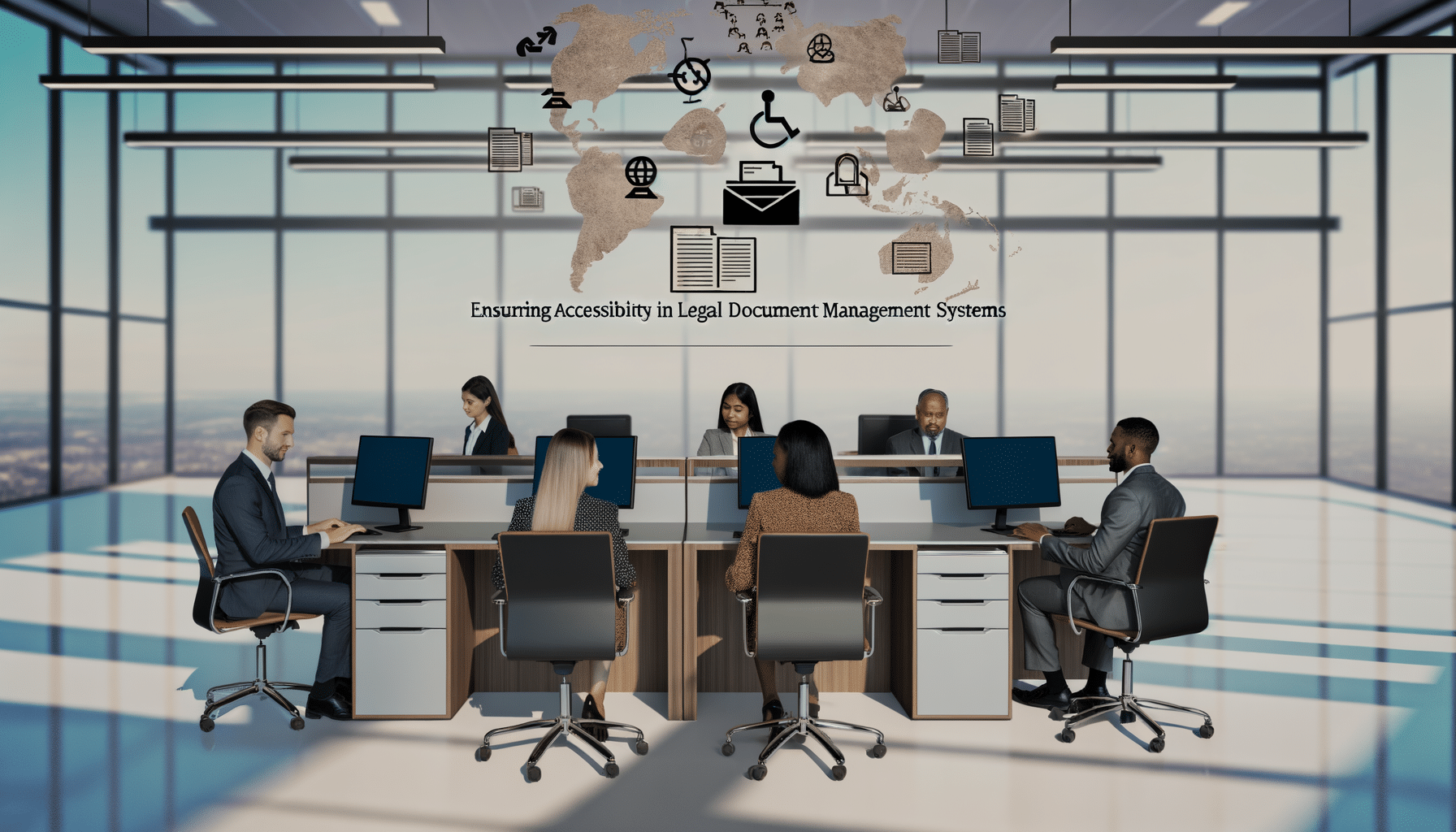- Inclusive Practices
- November 11, 2024
Ensuring Accessibility in Legal Document Management Systems

Legal document management systems (LDMS) have become essential tools in modern law firms and legal departments. As an entrepreneur committed to leveraging technology for the betterment of society, I understand the crucial role these systems play in ensuring efficiency, compliance, and security in record-keeping. Yet, one aspect that warrants significant attention is accessibility. Making legal document management systems accessible is not just about meeting regulatory requirements; it’s about inclusivity, enhancing user experience, and ensuring that everyone has equal access to crucial information.
Why Accessibility Matters in Legal Document Management
In the world of legal compliance and technology, accessibility is a multidimensional aspect that extends beyond physical alterations to include digital inclusivity. Let’s delve into why accessibility in legal document management systems is paramount:
- Regulatory Compliance: Laws such as the Americans with Disabilities Act (ADA) and the Web Content Accessibility Guidelines (WCAG) set standards for accessibility. Compliance is not an option—it’s a necessity.
- Enhanced User Experience: An accessible LDMS facilitates a smoother user experience, enabling users with various abilities to navigate and operate the system efficiently.
- Broader Reach: By integrating accessibility, firms enable more people to access legal services, broadening their client base and nurturing inclusivity.
- Brand Reputation: Emphasizing accessibility enhances a firm’s image as socially responsible and client-focused—an invaluable trait in today’s competitive market.
Key Elements of Accessibility in Legal Document Management Systems
In order to effectively implement accessibility, LDMS platforms must focus on certain key elements:
Usability for Screen Readers
Legal document management systems should be compatible with screen readers to assist the visually impaired. Elements such as headings, tags, and descriptive links enhance navigability. Using simple, clear language and providing alt text for images are effective strategies I recommend. Alt text not only enhances accessibility but also contributes to SEO optimization—a win-win situation for everyone involved.
Keyboard Navigation
Keyboard accessibility is crucial for individuals unable to use a mouse. Systems should allow users to navigate through commands using keyboard shortcuts. Ensuring all functionalities are available via keyboard-only navigation can significantly increase the accessibility of these platforms.
Inclusive Design
Interface designs should consider color contrast, text size adjustability, and simplified layouts. This aids users with visual impairments or cognitive challenges. Simplicity in design facilitates easier access to legal documents without overwhelming the user.
Voice Control and Speech Recognition
Integrating voice control functionalities can assist individuals with limited mobility. Legal document management systems should include robust speech recognition tools that ensure seamless interaction with the platform. This feature is particularly beneficial for those who find typing challenging.
Overcoming Challenges in Accessibility Implementation
While implementing accessibility measures is crucial, it’s not without challenges:
- Resource Allocation: The initial investment in making an LDMS accessible can be substantial, impacting smaller firms more significantly.
- Technology Integration: Seamlessly integrating accessibility features requires sustained technological upgrades and maintenance.
- Knowledge Gaps: Often, there’s a lack of awareness or expertise in accessibility best practices, necessitating targeted training and education.
Tackling these challenges involves a commitment to ongoing education, leveraging expert consultations, and utilizing modern technologies that facilitate simpler adaptation.
The Road Ahead: Best Practices for Ensuring Accessibility
As a proactive step towards inclusive legal technology, here are some best practices I advocate for implementing within legal document management systems:
- Conduct Accessibility Audits: Regularly audit your LDMS for accessibility barriers and compliance with relevant guidelines.
- Training and Awareness: Educate staff on accessibility standards and the importance of inclusivity within legal technology.
- User Feedback: Act on feedback from users with disabilities to fine-tune functionalities and ensure that the system meets their needs.
- Collaborative Development: Partner with accessibility experts during the development phase to incorporate the best accessibility practices effectively.
Embracing these strategies doesn’t just future-proof your firm against legal compliance issues—it ensures you are providing the best possible service to all your clients.
Conclusion
Incorporating accessibility into legal document management systems is an ethical imperative that aligns with values of inclusivity and fairness. Through consistent effort and commitment, we can bridge the gap between technology and accessibility, making legal services universally attainable. For more insights on how RecordsKeeper.AI and innovative technologies are shaping the future of legal compliance and record management, follow my entrepreneurial journey and stay updated with the latest developments.
Toshendra Sharma is the visionary founder and CEO of RecordsKeeper.AI, spearheading the fusion of AI and blockchain to redefine enterprise record management. With a groundbreaking approach to solving complex business challenges, Toshendra combines deep expertise in blockchain and artificial intelligence with an acute understanding of enterprise compliance and security needs.
Archives
- December 2024
- November 2024
- October 2024
- September 2024
- August 2024
- July 2024
- June 2024
- May 2024
- April 2024
- March 2024
- February 2024
- January 2024
- December 2023
- November 2023
- October 2023
- September 2023
- August 2023
- July 2023
- June 2023
- May 2023
- April 2023
- March 2023
- February 2023
- January 2023
- December 2022
- November 2022
- October 2022
- September 2022
- March 2019
Want to get more content like this?
Signup to directly get this type of content to your inbox!!
Latest Post
Organizing External Auditor Access
- December 22, 2024
Document Control in Manufacturing Plants
- December 21, 2024
Handling Rush Financial Report Requests
- December 20, 2024
Managing Record Access After Staff Changes
- December 19, 2024





